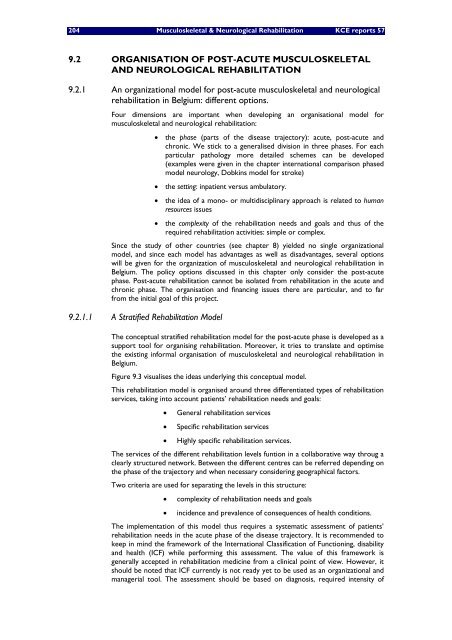The report is available in English with a French summary - KCE
The report is available in English with a French summary - KCE
The report is available in English with a French summary - KCE
You also want an ePaper? Increase the reach of your titles
YUMPU automatically turns print PDFs into web optimized ePapers that Google loves.
204 Musculoskeletal & Neurological Rehabilitation <strong>KCE</strong> <strong>report</strong>s 57<br />
9.2 ORGANISATION OF POST-ACUTE MUSCULOSKELETAL<br />
AND NEUROLOGICAL REHABILITATION<br />
9.2.1 An organizational model for post-acute musculoskeletal and neurological<br />
rehabilitation <strong>in</strong> Belgium: different options.<br />
Four dimensions are important when develop<strong>in</strong>g an organ<strong>is</strong>ational model for<br />
musculoskeletal and neurological rehabilitation:<br />
• the phase (parts of the d<strong>is</strong>ease trajectory): acute, post-acute and<br />
chronic. We stick to a general<strong>is</strong>ed div<strong>is</strong>ion <strong>in</strong> three phases. For each<br />
particular pathology more detailed schemes can be developed<br />
(examples were given <strong>in</strong> the chapter <strong>in</strong>ternational compar<strong>is</strong>on phased<br />
model neurology, Dobk<strong>in</strong>s model for stroke)<br />
• the sett<strong>in</strong>g: <strong>in</strong>patient versus ambulatory.<br />
• the idea of a mono- or multid<strong>is</strong>cipl<strong>in</strong>ary approach <strong>is</strong> related to human<br />
resources <strong>is</strong>sues<br />
• the complexity of the rehabilitation needs and goals and thus of the<br />
required rehabilitation activities: simple or complex.<br />
S<strong>in</strong>ce the study of other countries (see chapter 8) yielded no s<strong>in</strong>gle organizational<br />
model, and s<strong>in</strong>ce each model has advantages as well as d<strong>is</strong>advantages, several options<br />
will be given for the organization of musculoskeletal and neurological rehabilitation <strong>in</strong><br />
Belgium. <strong>The</strong> policy options d<strong>is</strong>cussed <strong>in</strong> th<strong>is</strong> chapter only consider the post-acute<br />
phase. Post-acute rehabilitation cannot be <strong>is</strong>olated from rehabilitation <strong>in</strong> the acute and<br />
chronic phase. <strong>The</strong> organ<strong>is</strong>ation and f<strong>in</strong>anc<strong>in</strong>g <strong>is</strong>sues there are particular, and to far<br />
from the <strong>in</strong>itial goal of th<strong>is</strong> project.<br />
9.2.1.1 A Stratified Rehabilitation Model<br />
<strong>The</strong> conceptual stratified rehabilitation model for the post-acute phase <strong>is</strong> developed as a<br />
support tool for organ<strong>is</strong><strong>in</strong>g rehabilitation. Moreover, it tries to translate and optim<strong>is</strong>e<br />
the ex<strong>is</strong>t<strong>in</strong>g <strong>in</strong>formal organ<strong>is</strong>ation of musculoskeletal and neurological rehabilitation <strong>in</strong><br />
Belgium.<br />
Figure 9.3 v<strong>is</strong>ual<strong>is</strong>es the ideas underly<strong>in</strong>g th<strong>is</strong> conceptual model.<br />
Th<strong>is</strong> rehabilitation model <strong>is</strong> organ<strong>is</strong>ed around three differentiated types of rehabilitation<br />
services, tak<strong>in</strong>g <strong>in</strong>to account patients’ rehabilitation needs and goals:<br />
• General rehabilitation services<br />
• Specific rehabilitation services<br />
• Highly specific rehabilitation services.<br />
<strong>The</strong> services of the different rehabilitation levels funtion <strong>in</strong> a collaborative way throug a<br />
clearly structured network. Between the different centres can be referred depend<strong>in</strong>g on<br />
the phase of the trajectory and when necessary consider<strong>in</strong>g geographical factors.<br />
Two criteria are used for separat<strong>in</strong>g the levels <strong>in</strong> th<strong>is</strong> structure:<br />
• complexity of rehabilitation needs and goals<br />
• <strong>in</strong>cidence and prevalence of consequences of health conditions.<br />
<strong>The</strong> implementation of th<strong>is</strong> model thus requires a systematic assessment of patients’<br />
rehabilitation needs <strong>in</strong> the acute phase of the d<strong>is</strong>ease trajectory. It <strong>is</strong> recommended to<br />
keep <strong>in</strong> m<strong>in</strong>d the framework of the International Classification of Function<strong>in</strong>g, d<strong>is</strong>ability<br />
and health (ICF) while perform<strong>in</strong>g th<strong>is</strong> assessment. <strong>The</strong> value of th<strong>is</strong> framework <strong>is</strong><br />
generally accepted <strong>in</strong> rehabilitation medic<strong>in</strong>e from a cl<strong>in</strong>ical po<strong>in</strong>t of view. However, it<br />
should be noted that ICF currently <strong>is</strong> not ready yet to be used as an organizational and<br />
managerial tool. <strong>The</strong> assessment should be based on diagnos<strong>is</strong>, required <strong>in</strong>tensity of

















